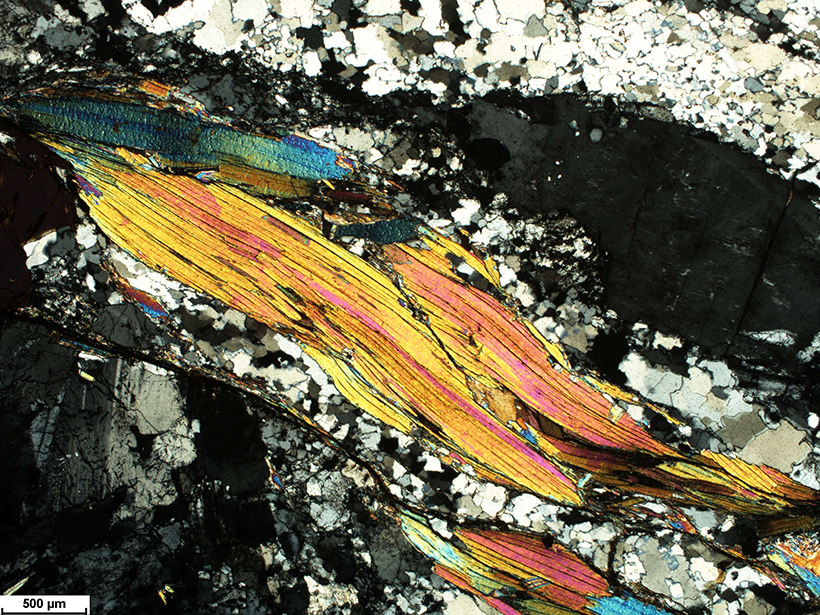The supercontinent Pangea was formed from titanic collisions of landmasses that folded and lifted Earth’s crust. Now, researchers have pieced together evidence about the mountains created by these collisions, though they have long since eroded away.
Using chemical measurements of 300-million-year-old precipitation from modern-day France, scientists have shown that the peaks situated roughly in the middle of Pangea were about as tall as the European Alps. Because mountainous geography affects atmospheric circulation, these results also shed light on the paleoclimate during the Carboniferous period, the researchers suggest.
“The roots of the mountains are outcropping at the surface.”
In 2016 and 2017, Camille Dusséaux, a geologist at the University of Plymouth in the United Kingdom, and her colleagues collected granite in northwestern and southern France. The sites they sampled contained the eroded remnants of the Variscan mountain belt, a span of mountain ranges created when the continents of Laurussia and Gondwana converged hundreds of millions of years ago. The granite the researchers collected was once 3–12 kilometers underground. “The roots of the mountains are outcropping at the surface,” said Dusséaux.
Dusséaux and her collaborators preferentially selected rocks in detachment zones, fractures in Earth’s crust. Detachment zones function like conduits that allow precipitation like rainwater and snowmelt (“meteoric water”) to percolate down, said Dusséaux.
Back in the laboratory, Dusséaux and her colleagues crushed the rocks and looked for muscovite, a mineral in the mica family. Because muscovite interacts with water, it records the chemistry of falling precipitation.
“The meteoric water goes down in the crust and exchanges with the muscovite,” said Dusséaux. “That will change its hydrogen and oxygen isotope composition.”
Isolating Isotopes
That’s important because in a twist of physics, the chemical composition of precipitation reflects a landscape’s topography.
Water molecules—each containing two hydrogen atoms and one oxygen atom—come in slightly different forms. Some water molecules contain deuterium, an isotope of hydrogen with one proton and one neutron in its nucleus (“heavy hydrogen,” 2H), rather than 1H, which contains only a proton in its nucleus. Water can also contain 18O, an isotope of oxygen with 8 protons and 10 neutrons in its nucleus, rather than 16O, which contains 8 protons and 8 neutrons.
In clouds, heavier water molecules—those containing deuterium or 18O—tend to condense before their lighter brethren and fall as precipitation. Therefore, a mass of air at higher elevation, which has condensed multiple times, tends to have fewer water molecules containing deuterium or 18O.
“Every time precipitation forms, the air mass will become more depleted in heavy isotopes,” said Dusséaux.
Dusséaux and her colleagues found that the muscovite in their samples was relatively depleted in deuterium, consistent with the original meteoric water falling from a higher elevation (i.e., over taller mountains). Using known relations linking the prevalence of deuterium-containing water molecules and elevation, Dusséaux and her collaborators estimated that the elevation of the Variscan mountain belt was once comparable to that of the European Alps.
“No one had ever measured the hydrogen before,” said Dusséaux. “This is the oldest hydrogen isotope composition of rainwater ever recovered.”
Contributions to Climate Modeling
These paleoaltimetry estimates reveal more than just topography. They’re also important for climate modeling because mountain ranges affect atmospheric circulation. For example, the contours of Himalayan peaks and valleys have been shown to affect monsoon precipitation.
“There are all of these mountain belts where I think this is the best approach.”
In agreement with previous research, Dusséaux and her colleagues suggest that modern-day France was previously located near the equator in a warm climate. These results, some of which were published in Terra Nova earlier this year, were presented at the 2019 Goldschmidt geochemistry conference last month in Barcelona, Spain.
“This was a really well done study,” said Page Chamberlain, a geochemist at Stanford University not involved in the research. A lot of research has focused on younger mountains, but no one had previously used this technique in the Carboniferous period, he said.
Dusséaux and her team’s methodology should be applied to other regions as well, said Chamberlain. “There are all of these mountain belts where I think this is the best approach.”
—Katherine Kornei (@katherinekornei), Freelance Science Journalist
Citation:
Kornei, K. (2019), Ancient precipitation reveals clues about mountains and climate, Eos, 100, https://doi.org/10.1029/2019EO133317. Published on 17 September 2019.
Text © 2019. The authors. CC BY-NC-ND 3.0
Except where otherwise noted, images are subject to copyright. Any reuse without express permission from the copyright owner is prohibited.

